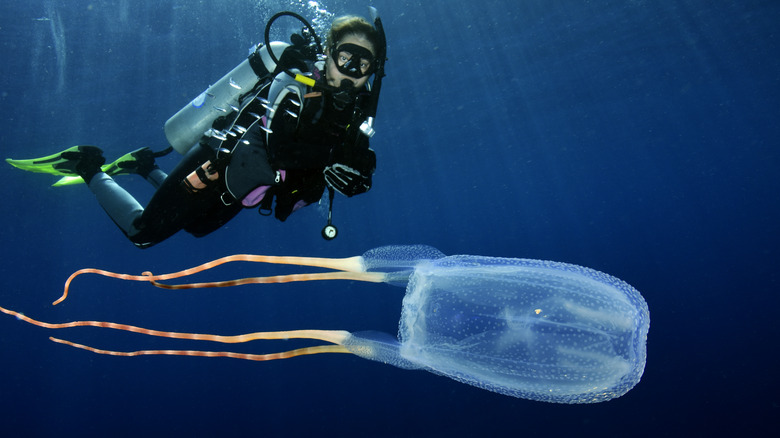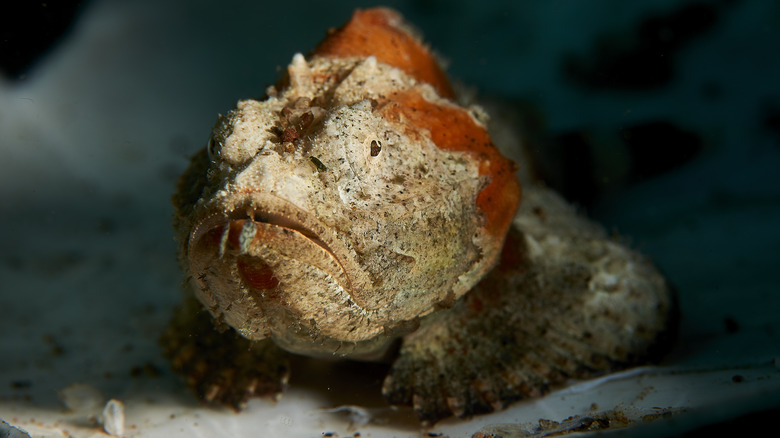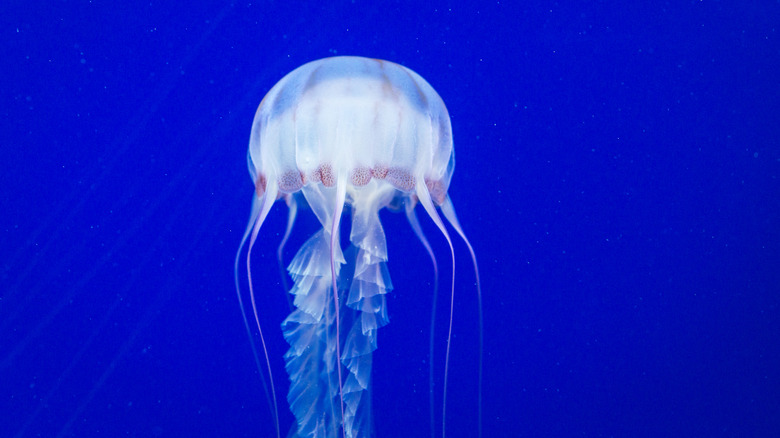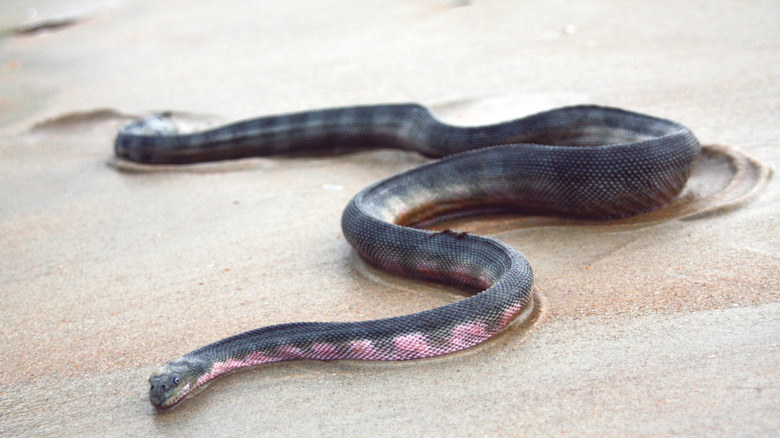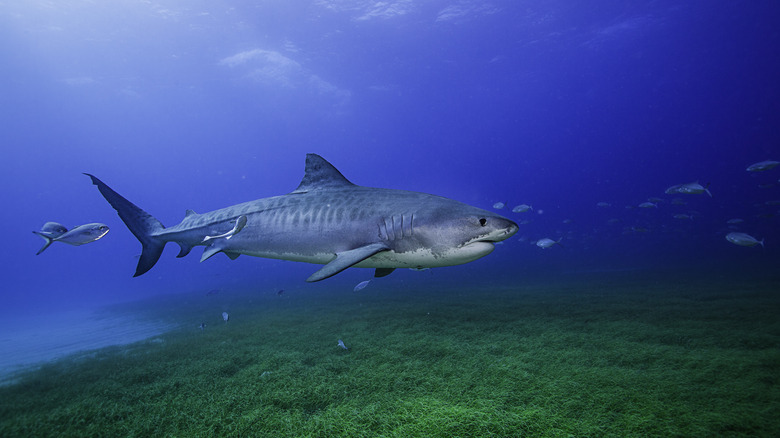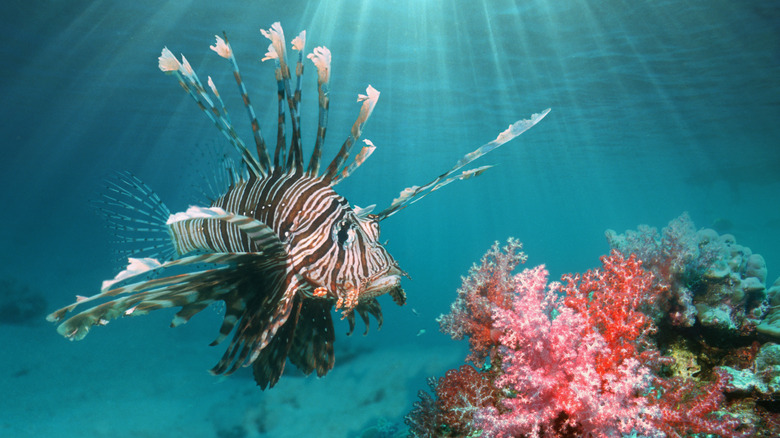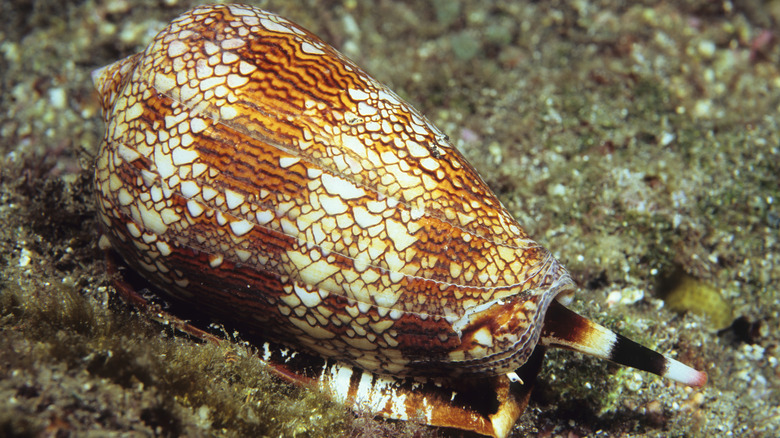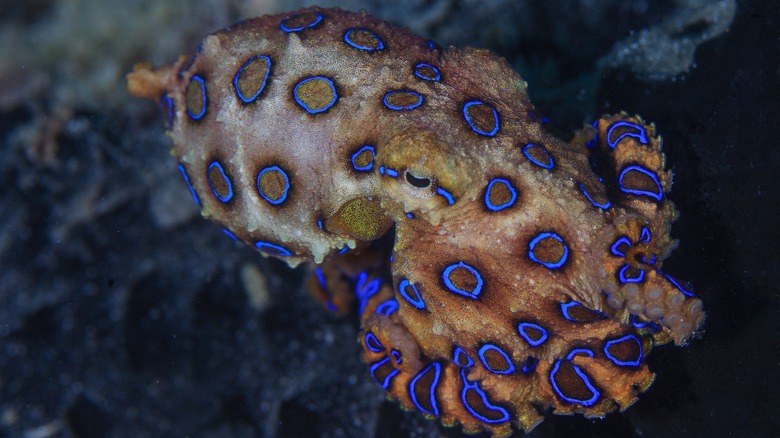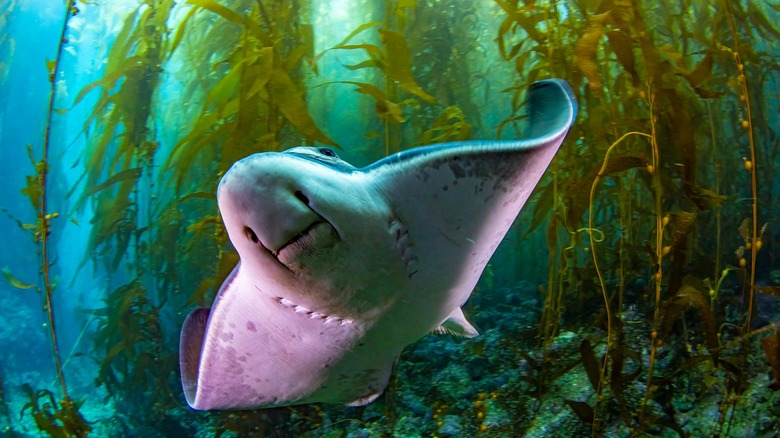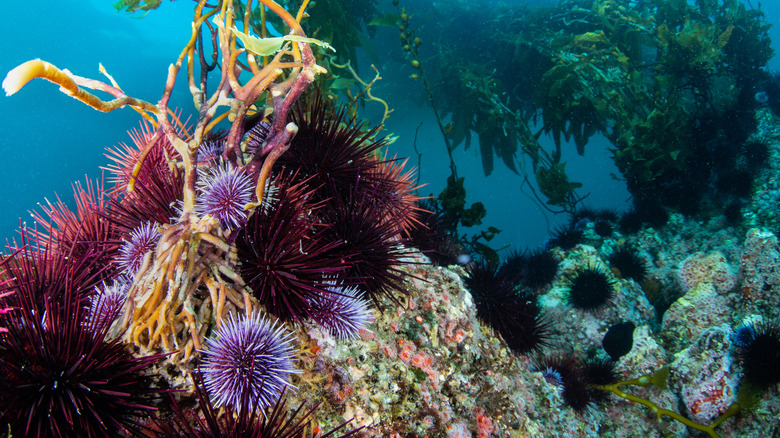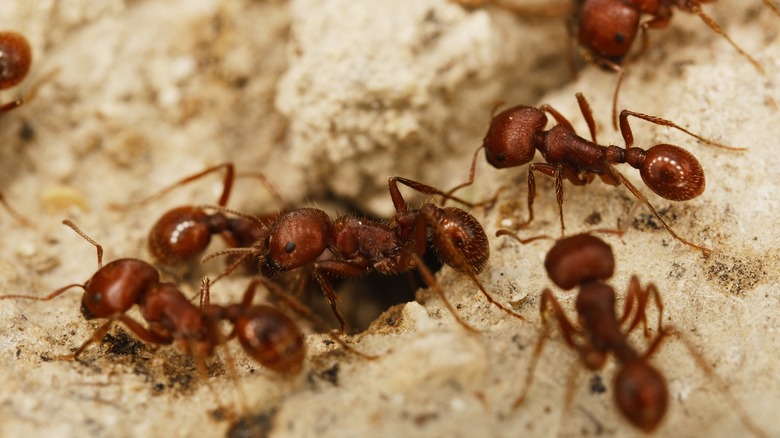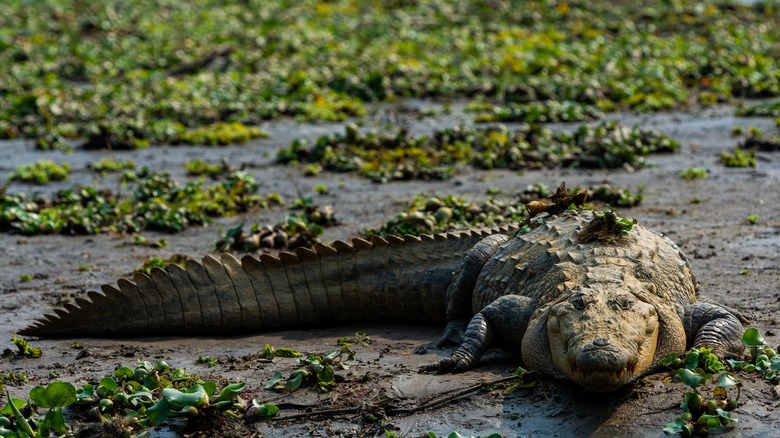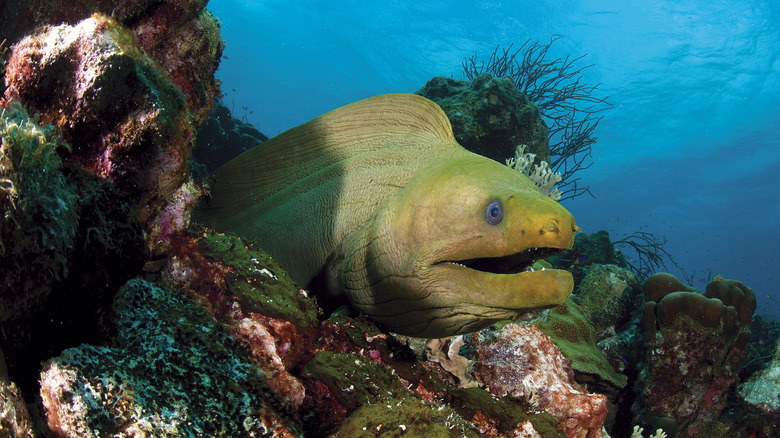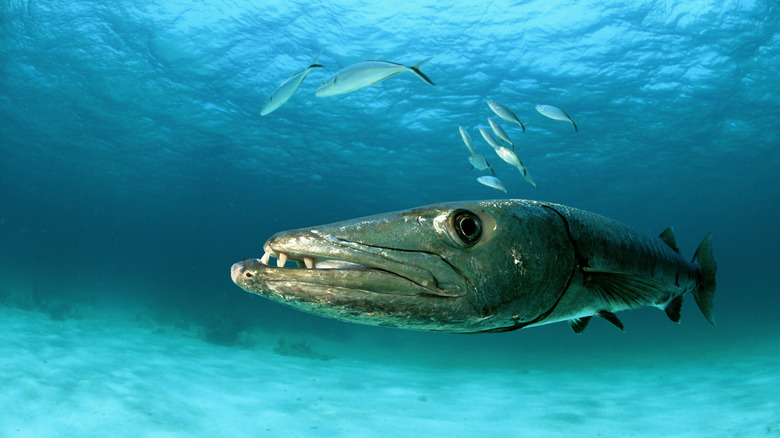The Most Dangerous Creatures You're Likely To Encounter On A Beach Vacation
Most people dream of spotting a dolphin from the shore on their next beach vacation, but there is a much higher chance that the creature they run into will be more dangerous than that. Every year hundreds of thousands of humans die from coming into contact with an animal, whether it be crocodiles or snakes. Unfortunately for vacationers, a variety of these potentially lethal creatures live on beaches around the world.
They swim through the water mere feet from where beach-goers splash in the shallows and scurry over the sand where vacationers are peacefully sunbathing. The truth is that if you're spending time at a beach, you will never be very far from an animal that could cause immense pain at best or even death at worst. The scariest part is that you would never suspect many of these critters to be so hazardous. Next time you're at the beach with your family, watch for these 13 dangerous creatures you could encounter on a coastal vacation.
Stonefish
With a reputation as one of the most venomous fish in the entire ocean, an encounter with a stonefish is something you'll definitely want to avoid on your next beach trip. These guys have a fairly large habitat across the Indo-Pacific Ocean and they can be found anywhere from the best beaches in all of Australia to East Africa. Unfortunately, it will be pretty difficult to spot one even if they're directly in front of you because these fish are masters of camouflage.
Stonefish have a textured body that is sometimes even covered in algae to appear as part of the reef or sand where they tuck themselves away. That's why it is so easy to accidentally step on one of them while you're wading around in the ocean and when that happens, all hell breaks loose. The stonefish has spines in its dorsal fin that inject victims with a highly toxic poison the moment they make contact with the sea creature. It is suspected that these little fishies have actually killed tons of Pacific and Indian Ocean islanders throughout history this way.
Once stung by it, the entire limb begins swelling and the victim experiences excruciating agony. One user on Reddit described the severity of a stonefish sting by stating, "Causes unbearable pain for days if not weeks on end. This pain is often reported to be so bad that a small portion of those who have the misfortune of experiencing it have committed suicide in order to try and escape it." Luckily, an anti-venom for it was created in 1959 to prevent death, but it is still an extremely unpleasant experience.
Box Jellyfish
Encountering a deadly box jellyfish is a risk that every vacationer runs when they're swimming in the Indo-Pacific waters near northern Australia— and here's what you need to know about the box jellyfish before your next vacation. Like many animals that call the sea their home, the box jellyfish is very tough to spot in the water while you're swimming. In this case, it is because their body is nearly translucent. This body includes a massive collection of tentacles that can grow up to 10 feet long and are laced with approximately 5,000 cells that possess the ability to shock its prey.
Getting stung by most species of jellyfish will simply be painful. However, the box jelly's sting can be lethal. If a human makes the mistake of knocking into one of these tentacles by accident, they will be shot with a toxin that causes an immediate rise in blood pressure.
This can make the heart stall out and eventually lead to death if it isn't immediately treated. 79 people have reportedly been killed by box jellyfish stings in Australia over the years. The most recent case was sadly of a 17-year-old boy who got stung by one of these sea creatures while going for a swim in Cape York.
Beaked sea snake
Encountering a snake is not usually on the mind of many beach-goers, but it should be a consideration if you're visiting a shoreline in places like Southeast Asia and the Persian Gulf. Beaches at these locations and a few others around the world are inhabited by the venomous beaked sea snake. These snakes can squirm through sand and stay underwater for up to 30 minutes at a time, so there is double the chance of running into one of these beasts. Even worse, they are said to be extremely aggressive the moment they start to feel threatened.
People who are unfortunate enough to be bitten by a beaked sea snake will get a dose of super powerful neurotoxins and mycotoxins that can be 10 times stronger than a cobra's venom. These compounds can stop the nerves from working properly and can cause the muscles to go into a state of paralysis. This means that the muscles that control breathing can stop functioning altogether and cause death.
Tiger Shark
If there is one beast lurking in the ocean that humans already fear, it is sharks. Vacationers try to steer clear of the most dangerous, shark-infested beaches in the world, but the truth is that most of these animals evade humans just as much. With that being said, there is one species of shark that is vicious and will happily attack people without provocation — the tiger shark.
While its more famous cousin the Great White usually stops attacking after a single bite, this type of shark will keep going until there is nothing left. A tiger shark will eat absolutely anything that crosses its path. Everything from lumps of coal and full-blown barrels to sea turtles and even other sharks have been found in their stomachs before.
Tiger sharks will swim around any type of warm-temperate waters and they tend to live in places like Florida, the Gulf of Mexico, and the Californian coast. It's a terrifyingly common occurrence to confront one of these ferocious menaces because they often stick around in shallow bays and river inlets. This wide territory range has enabled tiger sharks to kill 39 people in unprovoked attacks around the world so far.
Lionfish
The lionfish is an undeniably beautiful sea creature adjourned with brightly-colored spikes that make them one of the coolest fish to spot in the water when snorkeling. As pretty as they are, their protrusions are extremely dangerous because they contain an intense venom. If a person or any other being comes into contact with the fish, they will be smacked with a prompt wave of pain.
This is followed by even more unwelcome symptoms, such as swelling, nausea, numbness, dizziness, a fever, and even bodily convulsions. These effects can last up to a month after the original incident if the jab is bad enough. To save yourself from further consequences, you must painstakingly remove the barbs and soak the wound in warm water.
There is a chance of encountering these alien-looking animals in the South Pacific and Indian Oceans. Since it's a predator, lionfish can get combative if a person comes near or touches it. Not only can this creature be a major problem for individual beach-goers, but lionfish are also a threat to the ecosystem as a whole because they have become an invasive species in the Atlantic Ocean.
Cone Snails
Most vacationers wouldn't feel too threatened by a tiny snail at the beach, but that can be a serious mistake. Cone snails are one sneaky danger of snorkeling you shouldn't ignore. Native to tropical environments like shallow parts of the Great Barrier Reef and Hawaii, there are approximately 600 different kinds of cone snails and every single one is noxious. Instead of biting or being covered in spikes, the cone snail can protect itself by injecting its victim with poison using a covert, little tooth.
One Reddit user described how it works stating, "They're predatory mollusks and they use their poison stingers to paralyze and catch fish or other snails to eat, they evolved poison "harpoons" over time and became successful because of it." Getting pricked by the cone snail's tooth can quickly cause inflammation and its toxins can potentially induce paralysis that leads to respiratory failure and be fatal. Thankfully, you can eliminate the possibility of a sting from a cone snail by not picking up any creatures under the sea while you're snorkeling or scuba diving.
Blue-ringed octopus
It turns out that some of the most lethal creatures at the beach also happen to be the most mesmerizing. The blue-ringed octopus with its bright neon circles proves this theory. These sea-dwellers conceal themselves under rocks and in holes across the globe from Australia to the Philippines. While these organisms are actually quite passive and won't engage with humans unless they're messed with, they can be deadly under the wrong circumstances.
In fact, just one blue-ringed octopus has enough poison in its body to take out 26 fully grown adults in a matter of moments. The venom functions by stopping nerve impulses and limiting muscle contraction. It's believed that the type of neurotoxin these animals secrete is 1,000 times more toxic than cyanide.
The blue-ringed octopus is very small and typically only grows to 10 centimeters maximum. Since they're often perceived as cute to the unknowing eye, tourists have been known to ignorantly pick them up when they see one on the beach. As recently as 2023, a woman in Australia was bitten numerous times by one of these creatures when it slithered out of a shell and landed on her stomach. She said she was having abdominal pain and was immediately rushed to the hospital, but happily, she managed to survive the ordeal.
Stingray
Even though they're usually not aggressive, a stingray was responsible for one of the most infamous animal deaths in the world — Steve Irwin, "The Crocodile Hunter." The TV personality who rose to fame for fearlessly interacting with dangerous animals in the wild was filming in the Great Barrier Reef where he was looking for tiger sharks. Everything was going fine until suddenly a stingray attacked him, stabbing him in the chest with its barbed tail multiple times until he died a few minutes later. A cameraman who captured the horrifying incident said to The Guardian, "It went through his chest like a hot knife through butter."
The Steve Irwin attack was a freak accident that very rarely happens at the beach, but the truth remains that stingrays can be incredibly dangerous. Stingrays often nestle themselves in the sand of shallow, tropical waters and if a beach-goer accidentally steps on one, it can spell out disaster. Not only do they have a tail that can be used as an underwater weapon, but it is also lined with poisonous spikes.
Sea Urchin
Sea urchins are one of the few deadly sea creatures that have species living in every single ocean on the planet. While some of these 950 species live in the deepest depths of the sea which humans can't reach, others stay near the seashore where families enjoy their beach vacations. Encountering one of them on a beach trip is well within the realm of possibility.
Sea urchins move around the ocean with the help of tiny feet called pedicellariae. These spines can cause a laceration when touched and many sea urchin species have toxic pedicellariae. After contact, the area where the sting occurs becomes swollen and red, followed by sensitivity and muscle aches.
The wounds can also become infected if pieces of the spikes are left in the skin to fester. One person who had experienced a sea urchin sting shared, "I had over 20 pieces in my hand. It did not go well. Hand surgery was required a month later." It's recommended to shuffle your feet across the sea floor if you can't see where you're stepping to avoid one of these painful stings.
Fire Ants
Australia's beaches are a hotbed for all types of sketchy animals and fire ants can be one of the most annoying of them all. They're also found in warm climates across the United States, such as Alabama and Georgia. A bite from just a single fire ant alone will inflict a jolt of pain, causing extremely uncomfortable swelling and redness. Eventually, the site of the bite will turn into a blister-like wound.
However, just one measly sting is usually survivable and won't impact you long-term. The problem is that these insects typically attack as an entire colony and can perpetrate hundreds of bites in a very short span of time. Individuals who are unlucky enough to endure multiple fire ant stings can experience deadly consequences. Since their bites contain venom, getting attacked by many of them at once can potentially cause death from anaphylactic shock.
While it's extremely rare, there have been cases of people getting attacked by only one fire ant and dying from a severe allergic reaction. In 2023, a mother named Cathy Weed accidentally stepped on a fire ant hill in Georgia and was bitten by just one of the insects. Sadly, she had such a bad allergic reaction from venom she passed away before she could get help.
Saltwater Crocodile
Saltwater crocodiles aren't just one of the most lethal predators at the beach — they are one of the top 10 most dangerous animals to humans on the planet. Every single year, these beasts murder approximately 1,000 people. That should be enough reason to stay far away from the most crocodile-infested waters across the U.S. and beyond.
These predators hunt in mangrove swamps all over the globe from Fiji and Australia to the Caribbean and the southern United States. They are one of the most colossal reptiles still alive today with adult males growing up to 22 feet long and weighing up to 2,200 pounds. In addition to its terrifying size, the saltwater crocodile also has one of the most powerful bites of any animal in the world with a force of 4,000 pounds per square inch (PSI). To put that in perspective, an adult human being has a bite force of just 162 PSI.
Moray Eel
Moray Eels tend to avoid humans and prefer to hide out between rocks, but scuba divers still run the risk of coming face-to-face with these ocean critters. These animals are typically found in the western Atlantic Ocean and the northern Gulf of Mexico. The main concern with moray eels is that they have razor-sharp teeth and extremely strong jaws. There is also poison in their mucus that can create additional problems if you're attacked by one of them.
While they are usually quite docile, there is always the potential for a moray eel attack if they feel like they're in danger. As one diver on Reddit explained, "Of course, like with any wild animal, they will fight back if feeling threatened and can easily chomp off a finger." It's recommended to keep a safe distance from rocks or reef crevices where these eels might live to steer clear of an attack.
If you do get caught in the mouth of a moray eel, the wound will quickly start to bleed and swell up instantaneously. Depending on the severity of the bite, a tetanus shot, antibiotics, stitches, or even surgery may be required to treat a moray eel injury.
Barracuda
Barracudas are a terrifying-looking marine animal that can be dangerous to humans if they're in the wrong place at the wrong time. They are known to live all over the world, including the Caribbean Sea, the Gulf of Mexico, the western Atlantic Ocean, the Red Sea, and more. As many sea creatures do, barracudas try their best to stay away from people in the ocean. However, if a human comes across their path while they're spearfishing, snorkeling, or diving, barracudas can get defensive and attack.
These fish are predators of the sea and they have an impressive jaw with two sets of needle-sharp teeth that can effortlessly rip through its prey. These chompers can cause severe lacerations to humans that require medical attention. In 2022, an elderly tourist in the Cayman Islands learned this firsthand when a sea creature, possibly a barracuda came out of nowhere to attack her right arm and she had to be hospitalized. There are a few precautions that beach-goers can take to escape this fate, such as taking off any reflective jewelry that might attract a barracuda and not making any fast movements if you do come across one in the water.
